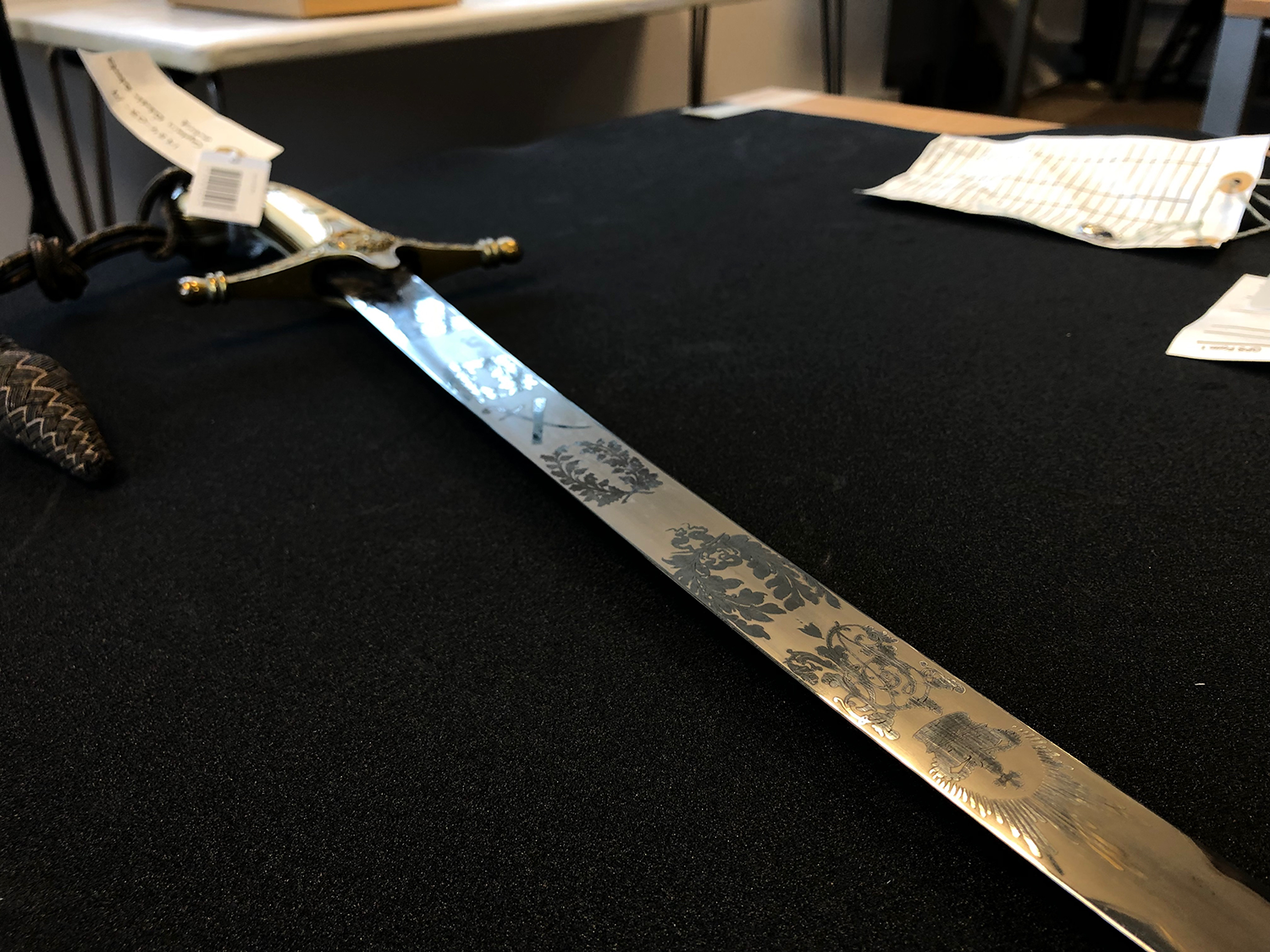At Meyer & Mortimer, we do not have many opportunities for a day out. If we are to leave the shop, it's to pop out to run an errand or – for more extended periods - visit our customers overseas. It was then, with great excitement, that the National Army Museum (NAM) invited us out to visit their warehouse collection. With a fraction of their vast store on show at any given time it means the rest of their garments, vehicles, weapons and prints are stored elsewhere. Other than being told, we were going to see some of Meyer & Mortimer's past work; we were not fully expecting what we were to see that day.
The National Army Museum in London’s Chelsea
Before we start, a little context: Over the years, we've got to know the Army Museum very well. We have a lot in common. At Meyer & Mortimer, we have a proud history of making bespoke uniforms for army officers. The National Army Museum is the leading authority on the British Army. Through their museum and the many fascinating exhibitions, they measure our army's impact on society – past and present.
As previously mentioned, the NAM has accumulated a massive inventory of items. Even the list of collections is too long to detail here. However, some of those include film footage, art, medals, flags, vehicles and of course, weapons and uniforms. It is in the two latter categories that several items from Meyer & Mortimer’s past found themselves and was the reason for them to get in touch with us.
Brian hosting the NAM in March, 2015
In 2015, we hosted a fundraising event for the NAM at our showroom in Mayfair. The museum was closed at the time for a major refurbishment, so we were happy to help out. We covered it at the time with a piece called Shared Histories. It was at that event that Ian Maine, who is the Assistant Director for Collections and Programme at NAM, met our director, and resident historian, Brian Lewis. It was an opportunity for them to talk about military uniforms and the construction techniques used to make them. It was a conversation that Ian remembered, particularly as they are now researching for a new exhibition and were looking to connect with military uniform makers. Ian got back in touch in April 2019, and Brian invited him and his team to the showroom.
The National Army Museum Visit Meyer & Mortimer
So in May 2019, Ian and Sophie Anderton (Curator) came to visit us at 6 Sackville Street to talk about our history of making uniforms and swords. Before their visit, they discovered several Meyer & Mortimer garments in their collection, as well as three of our swords. We are known for our military and bespoke civilian suits, but we did, at one time, make the odd weapon or two.
Ian Maine, Brian Lewis & Sophie Anderton at M&M
It proved to be a fascinating meeting for everyone involved. Unfortunately, we are unable to share any details. The overall theme of the exhibition is kept under wraps until the museum announces it in due course. Once it is open, we will share the details of it here on our website.
Please visit our Contacts page to sign up for email alerts (bottom of page)
Brian takes Ian and Sophie though the ledger
We did, however, get to share our ledger with them. It is the only surviving document that lists customers and their tailoring orders from 1809-1824. The other ledgers were lost when our old address on Conduit Street was bombed in WWII (Read more about this on our History page). It is a weighty tome with beautiful hand-written entries detailing orders from the likes of The Prince Regent, later King George IV, and leading aristocrats and military commanders of the day. Both Sophie and Ian were gripped with every turn of the page and promised they would be back to spend more time going through its history.
It concluded their visit, but before they left, they extended an invitation to come and visit the National Army Museum warehouse collection. Not only would it be an opportunity for us to see some of our past work, but it would be fascinating to see the many other items stored away from the general public. We, of course, accepted before bidding Sophie and Ian a fond farewell.
Meyer & Mortimer Visit The National Army Museum
Over the next week or two, we coordinated diaries, and agreed on a date in July to visit the NAM warehouse collection. On an early summer's hot day, Brian and I (Jason from Marketing) arrived and were warmly greeted by Sophie Anderton and Sophie Stathi (Curator) who directed us to a small room. In there, three ornate ceremonial swords lay on a protective cloth on a table, and three tailor's dummies, displaying our work, stood idle around the table.
Meyer & Mortimer Ceremonial Swords
The swords of Meyer & Mortimer
Despite their years, the swords looked impressive, particularly the decorative guards and grips and the elaborate and almost fluid movement of the knuckle guards. All three swords were over one-hundred years old. Although descended from weapons, ceremonial swords rarely saw combat. They are mainly used in parades and as part of dress uniforms. We must add, we are no longer sword makers, so our knowledge is limited. We instead rely on information kindly provided by Sophie Anderton.
Staff Officer’s Sword - 1831
Please click on the images to enlarge
The first sword which was a staff officer's associated to a Major General G. Ricketts Roberts who served in the Bengal Staff Corp. Engraved below the guard is our old name, J & J Meyer, and our old address on 36 Conduit Street. As the images below show, it is an elegant looking sword with some beautifully engraved images along the blade.
Royal Artillery Officer's Sword - 1855
Still looking good at over 160 years old
Next is a Royal Artillery officer's sword, 1855 (c) associated with the Turkish Contingent, Crimean War. (1854-1856). Out of the three, it is less flamboyant in design than the others. Where it lacks in gold, it makes it up with an elaborate loop guard protecting the grip. For more information on this sword, please visit the NAM site.
Steel Lord Lieutenant of Counties Sword
Queen Victoria's Royal Cypher
The last, of the three swords, is a Steel Lord Lieutenant of Counties sword. It was made by ourselves in 1898 (c). The blade has a Queen Victoria's Royal Cypher and the silver rose on the escusson denotes English counties.
Bespoke Military Uniforms
There were three sets of garments at our meeting that day. We can, however, only discuss two here as the other uniform, made by ourselves, will form part of the exhibition. Please click on the images to expand.
Brian Lewis with a Military Knights frock coat
The first garment is a frock coat and trousers made for Major Sir Peter Downward of the Military Knights of Windsor in 1990. As proud Royal Warrant Holders to Her Majesty Queen Elizabeth II, we make the uniforms for the Military Knights of Windsor. They are a body of retired military officers who receive a pension and accommodation, courtesy of the Queen, at Windsor Castle. They provide support for the Order of the Garter and services at St George's Chapel, Windsor.
Our past Royal Warrants
Although this falls into Brian's time at Meyer & Mortimer (he started in 1963) it was his old boss, John Peacock, who would've looked after the Military Knights at the time. Brian remembers Sir Peter Downward coming into the shop, but he was not responsible for making it. Brian was handed the honour of looking after the Military Knights tailoring needs in 1997.
AlfonsoXIII mess jacket
We have a history of clothing royalty here and abroad with our last garment, for now, falling into the latter. It is an officer's mess jacket (Army Staff, Field Marshal) worn by Alfonso XIII, King of Spain during his position as colonel-in-chief of the 16th Lancers and 16th/5th Lancers, 1905-1941. Although the need for making mess jackets has diminished over the years, we are still called on to make one from time to time.
INTO THE WAREHOUSE
Jason Smith, Brian Lewis, Sophie Anderton & Sophie Stathi
After spending about an hour looking through the swords and garments, it was time to be shown around the warehouse collection. At the end of a small corridor, we walked through an unassuming door into a scene that would not look out of place in an Indiana Jones movie. We found ourselves in a high ceilinged warehouse full of old army vehicles, canons with vast amounts of wooden boxes stacked on top of one another. Behind containers were army medic vans, bits of the Berlin Wall and vintage army motorcycles. It felt like every way we turned revealed some treasure. It was an incredible surprise. Sophie Anderton told us that fitting everything in is ‘like putting a jigsaw together, albeit with full-size military vehicles’.
The NAM vehicle collection - please click on images to expand
In the next main space, they keep the uniforms, weapons and ammunition as well as other small bits of equipment. Ghostlike the uniforms are protected in white bags and hung on four or more rails extending from floor to ceiling with the walkways between them disappearing into the darkness. Sophie Anderton mentioned she is continuously amazed by what she finds when looking for other items. Not only are their objects associated with the British Army, but also with their our enemies. On descending a ladder once she noticed, on a middle shelf, an old telephone switchboard. The interesting thing about this particular switchboard was the names on the connections: Hitler, Himmler and Goebbels.
The NAM’s rather large walk-in-wardrobe
Along the wall, large drawers were pulled out to show military artwork and old recruitment posters. Other drawers revealed embroidered flags displaying regimental colours and emblems. Such is the size of their collection both Sophie Anderton and Sophie Stathi, told us they are continually finding new things.
After another hour, it was time for us to return to our shop in London. It was in every sense of the word fascinating. Fascinating for the dizzying amount of enchanting objects with each one containing a story. With a fraction of the collection on show at the museum, the job is not only of storage at the warehouse but on what stories to share with the general public. With pieces added all the time, it means the National Army Museum will never run out of content. It makes us very proud indeed to know that our work is but a very small part of their collection. A collection that will outlive us all and tell many stories for centuries to come.







































